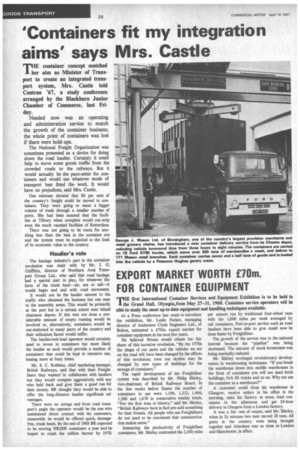'Containers fit my integration aims' says Mrs. Castl
Page 28

If you've noticed an error in this article please click here to report it so we can fix it.
container concept matched her aim as Minister of Transport to create an integrated transport system, Mrs. Castle told Contran '67, a study conference arranged by the Blackburn Junior Chamber of Commerce, last Fri day.
Needed now was an operating and administration service to match the growth of the container business; the whole point of containers was lost if there were hold-ups.
The National Freight Organization was sometimes presented as a device for doing down the road haulier. Certainly it could help to move some goods traffic from the crowded roads to the railways. But it would actually be the pace-setter for containers and would use whatever mode of transport best fitted the work. It would have no prejudices, said Mrs. Castle.
One estimate showed that 80 per cent of the country's freight could be moved in containers. They were going to mean a bigger volume of trade through a smaller number of ports. She had been assured that the facilities at Tilbury when complete would out-strip even the much vaunted facilities of Rotterdam.
There was not going to be room for anything less than the best in the container era and the system must be exploited to the limit of its economic value to the country.
Haulier's role
The haulage industry's part in the container revolution was dealt with by Mr. J. G. Griffiths, director of Northern Area Transport Group Ltd., who said that road haulage had a special part to play, for whatever the form of the trunk haul—air, sea or rail—it would begin and end with road movement.
It would not be the haulier nearest to the traffic who obtained the business but one near to the assembly areas. This would be primarily at the port but to a certain extent near inland clearance depots. If this was not done a considerable amount of empty running would be involved or, alternatively, containers would be out-stationed in many parts of the country and their utilization factor would suffer.
The haulier/unit-load operator would certainly need to invest in containers but more likely the haulier as such would provide a nucleus of containers that could be kept in intensive use, leasing more at busy times.
Mr. S. C. Robbins, chief marketing manager, British Railways, said that with their Freightliners they wanted 'to collaborate with hauliers but they would compete aggressively with any who held back and give them a good run for their money. BR thought they would be able to offer the long-distance haulier significant advantages.
There were no strings and from road transport's angle the operator would be the one who maintained direct contact with his customers, meanwhile he would be offered quick, damagefree, trunk hauls. By the end of 1968 BR expected to be moving 500,000 containers a year and he hoped to crash the million barrier by 1970.
























































































































